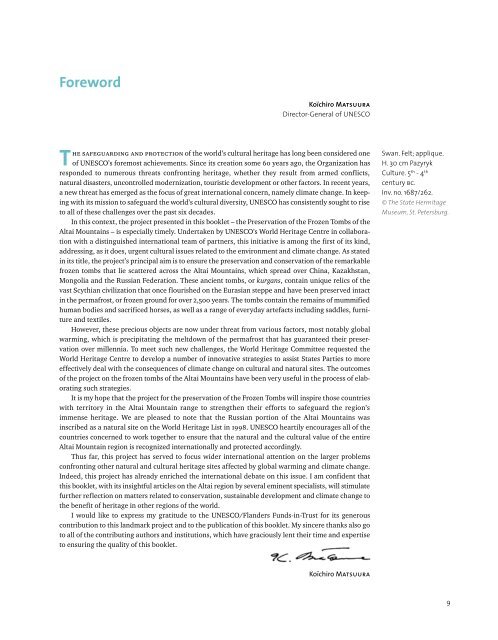Scythian Culture - Preservation of The Frozen Tombs of The Altai Mountains (UNESCO)
You also want an ePaper? Increase the reach of your titles
YUMPU automatically turns print PDFs into web optimized ePapers that Google loves.
Foreword<br />
Koïchiro Matsuura<br />
Director-General <strong>of</strong> <strong>UNESCO</strong><br />
<strong>The</strong> safeguarding and protection <strong>of</strong> the world’s cultural heritage has long been considered one<br />
<strong>of</strong> <strong>UNESCO</strong>’s foremost achievements. Since its creation some 60 years ago, the Organization has<br />
responded to numerous threats confronting heritage, whether they result from armed conflicts,<br />
natural disasters, uncontrolled modernization, touristic development or other factors. In recent years,<br />
a new threat has emerged as the focus <strong>of</strong> great international concern, namely climate change. In keeping<br />
with its mission to safeguard the world’s cultural diversity, <strong>UNESCO</strong> has consistently sought to rise<br />
to all <strong>of</strong> these challenges over the past six decades.<br />
In this context, the project presented in this booklet – the <strong>Preservation</strong> <strong>of</strong> the <strong>Frozen</strong> <strong>Tombs</strong> <strong>of</strong> the<br />
<strong>Altai</strong> <strong>Mountains</strong> – is especially timely. Undertaken by <strong>UNESCO</strong>’s World Heritage Centre in collaboration<br />
with a distinguished international team <strong>of</strong> partners, this initiative is among the first <strong>of</strong> its kind,<br />
addressing, as it does, urgent cultural issues related to the environment and climate change. As stated<br />
in its title, the project’s principal aim is to ensure the preservation and conservation <strong>of</strong> the remarkable<br />
frozen tombs that lie scattered across the <strong>Altai</strong> <strong>Mountains</strong>, which spread over China, Kazakhstan,<br />
Mongolia and the Russian Federation. <strong>The</strong>se ancient tombs, or kurgans, contain unique relics <strong>of</strong> the<br />
vast <strong>Scythian</strong> civilization that once flourished on the Eurasian steppe and have been preserved intact<br />
in the permafrost, or frozen ground for over 2,500 years. <strong>The</strong> tombs contain the remains <strong>of</strong> mummified<br />
human bodies and sacrificed horses, as well as a range <strong>of</strong> everyday artefacts including saddles, furniture<br />
and textiles.<br />
However, these precious objects are now under threat from various factors, most notably global<br />
warming, which is precipitating the meltdown <strong>of</strong> the permafrost that has guaranteed their preservation<br />
over millennia. To meet such new challenges, the World Heritage Committee requested the<br />
World Heritage Centre to develop a number <strong>of</strong> innovative strategies to assist States Parties to more<br />
effectively deal with the consequences <strong>of</strong> climate change on cultural and natural sites. <strong>The</strong> outcomes<br />
<strong>of</strong> the project on the frozen tombs <strong>of</strong> the <strong>Altai</strong> <strong>Mountains</strong> have been very useful in the process <strong>of</strong> elaborating<br />
such strategies.<br />
It is my hope that the project for the preservation <strong>of</strong> the <strong>Frozen</strong> <strong>Tombs</strong> will inspire those countries<br />
with territory in the <strong>Altai</strong> Mountain range to strengthen their efforts to safeguard the region’s<br />
immense heritage. We are pleased to note that the Russian portion <strong>of</strong> the <strong>Altai</strong> <strong>Mountains</strong> was<br />
inscribed as a natural site on the World Heritage List in 1998. <strong>UNESCO</strong> heartily encourages all <strong>of</strong> the<br />
countries concerned to work together to ensure that the natural and the cultural value <strong>of</strong> the entire<br />
<strong>Altai</strong> Mountain region is recognized internationally and protected accordingly.<br />
Thus far, this project has served to focus wider international attention on the larger problems<br />
confronting other natural and cultural heritage sites affected by global warming and climate change.<br />
Indeed, this project has already enriched the international debate on this issue. I am confident that<br />
this booklet, with its insightful articles on the <strong>Altai</strong> region by several eminent specialists, will stimulate<br />
further reflection on matters related to conservation, sustainable development and climate change to<br />
the benefit <strong>of</strong> heritage in other regions <strong>of</strong> the world.<br />
I would like to express my gratitude to the <strong>UNESCO</strong>/Flanders Funds-in-Trust for its generous<br />
contribution to this landmark project and to the publication <strong>of</strong> this booklet. My sincere thanks also go<br />
to all <strong>of</strong> the contributing authors and institutions, which have graciously lent their time and expertise<br />
to ensuring the quality <strong>of</strong> this booklet.<br />
Swan. Felt; applique.<br />
H. 30 cm Pazyryk<br />
<strong>Culture</strong>. 5 th - 4 th<br />
century bc.<br />
Inv. no. 1687/262.<br />
© <strong>The</strong> State Hermitage<br />
Museum, St. Petersburg.<br />
Koïchiro Matsuura<br />
9
















